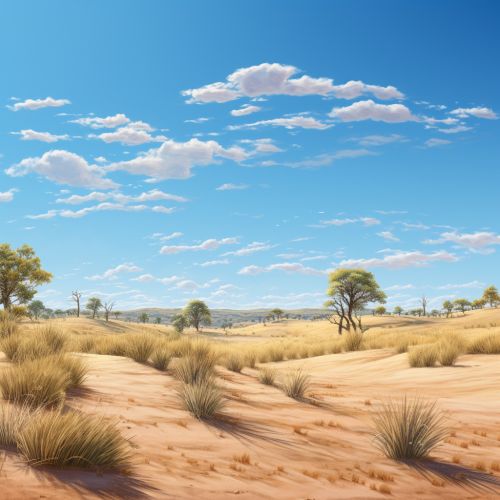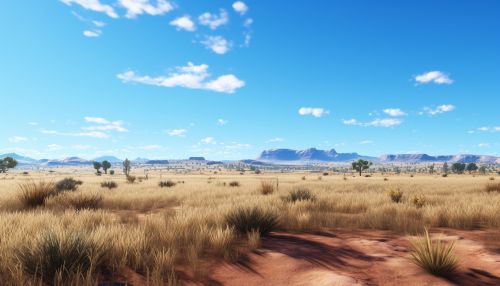Desert ecology
Introduction
Desert ecology refers to the study of the interactions between both biotic and abiotic components in desert environments. Deserts, defined by their low precipitation and high evaporation rates, are unique ecosystems that harbor a variety of specialized plant and animal species. These species have evolved various adaptations to survive in the harsh desert conditions.


Classification of Deserts
Deserts can be classified into four types based on their geographical location and climatic conditions: hot and dry deserts, semi-arid deserts, coastal deserts, and cold deserts. Each of these desert types has a unique set of environmental conditions and therefore supports a distinct community of plants and animals.
Hot and Dry Deserts
Hot and dry deserts, also known as subtropical deserts, are characterized by high temperatures and low rainfall. They are typically found around the Tropics of Cancer and Capricorn. The Sahara, the world's largest hot desert, is a prime example of this type of desert.
Semi-arid Deserts
Semi-arid deserts, also known as cold-winter deserts, experience hot summers and cold winters with slightly more rainfall than hot and dry deserts. The Mojave in the United States is an example of a semi-arid desert.
Coastal Deserts
Coastal deserts are found in moderately cool to warm areas along the coastlines. They have cool winters and long, warm summers. The Atacama in Chile, the world's driest desert, is a coastal desert.
Cold Deserts
Cold deserts, also known as polar deserts, have cold winters and short, moderately warm summers. The Antarctic, the world's largest desert, is a cold desert.
Desert Flora
Desert plants, also known as xerophytes, have developed unique adaptations to survive in the arid desert environment. These adaptations include deep root systems, reduced leaf size, and the ability to store water in their stems or leaves. Some common desert plants include cacti, succulents, shrubs, and grasses.
Cacti
Cacti are a group of succulent plants that are native to the deserts of the Americas. They have thick, fleshy stems that store water and are covered in spines, which protect them from herbivores and provide shade to reduce water loss.
Succulents
Succulents are a diverse group of plants that store water in their leaves, stems, or roots. They have a waxy or hairy coating on their leaves to reduce water loss through evaporation.
Shrubs and Grasses
Desert shrubs and grasses have deep root systems that can tap into groundwater sources. They also have small, narrow leaves to minimize water loss.
Desert Fauna
Desert animals have also evolved various adaptations to survive in the harsh desert environment. These adaptations include nocturnal behavior, burrowing, and the ability to go without drinking water for extended periods.
Mammals
Desert mammals, such as the Fennec Fox and the Kangaroo Rat, are often small and nocturnal. They burrow during the day to avoid the heat and come out at night to feed.
Reptiles
Desert reptiles, such as snakes and lizards, are ectothermic, meaning they rely on the environment to regulate their body temperature. They bask in the sun to warm up and seek shade or burrow to cool down.
Birds
Desert birds, such as the Roadrunner and the Sandgrouse, have adaptations to conserve water. Some desert birds get their water from their food, while others have specialized kidneys to excrete excess salt and conserve water.
Human Impact on Desert Ecosystems
Human activities, such as agriculture, mining, and urbanization, have significant impacts on desert ecosystems. These activities can lead to habitat loss, species extinction, and changes in desert landscapes. Conservation efforts are crucial to protect and preserve these unique ecosystems.
See Also
References
1. "Desert Biomes." Encyclopedia of Earth. 2. "Desert Ecosystems." National Geographic. 3. "Desert Flora and Fauna." DesertUSA.
